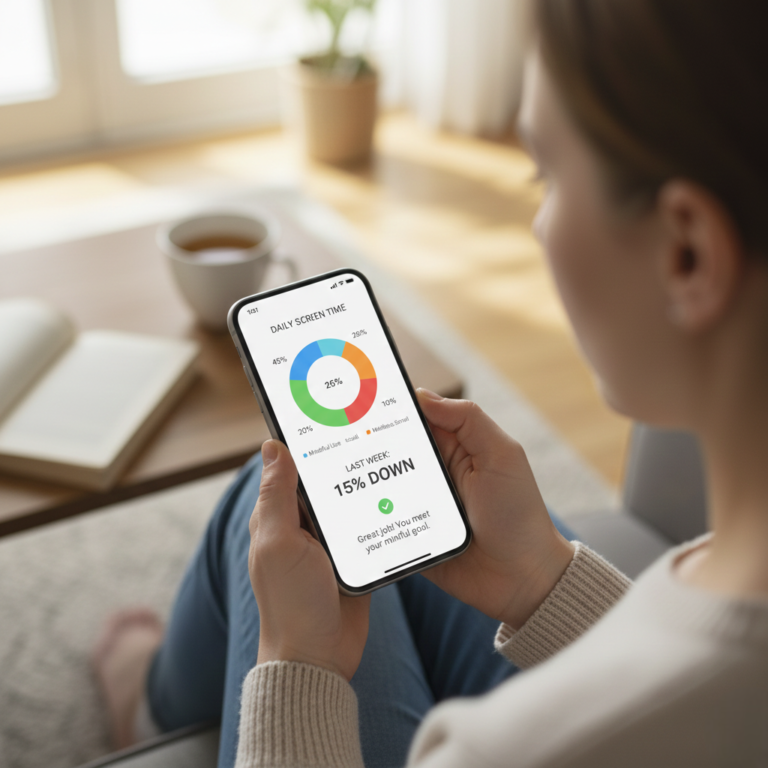
Are you finding it increasingly difficult to concentrate on a single task? Do you experience a surge of anxiety when separated from your devices? Is your sleep becoming shallower and less restorative despite feeling constantly fatigued? Ever wonder what happens inside your brain during a Digital Detox? Constant notifications and endless scrolling create a dopamine feedback loop, keeping your brain craving the next hit of digital stimulation.
These symptoms aren’t just modern inconveniences—they’re neurological responses to our hyperconnected digital lifestyle. The average American now spends over 7 hours daily on screens, with 65% checking their phones within 5 minutes of waking. More alarmingly, neuroimaging studies from UCLA show that constant digital multitasking is associated with decreased gray matter density in the anterior cingulate cortex—a region crucial for attention and emotional regulation.
As a neuroscientist specializing in digital behaviors and cognitive function, I’ve spent the past decade researching how modern technology usage patterns are literally reshaping our neural circuitry. The evidence is compelling: our digital habits are fundamentally altering our brain structure and function, but the remarkable neuroplasticity that makes this possible also gives us the power to reverse these changes.

In this evidence-based guide, you’ll discover:
- The specific neural mechanisms affected by excessive screen time
- How digital overload disrupts your brain’s reward system and attention networks
- The documented cognitive, emotional, and physical benefits of strategic unplugging
- A structured 30-day neurologically-informed digital detox plan
- Science-backed techniques to maintain optimal brain function in a digital world
By the end of this article, you’ll understand not just why you feel digitally overwhelmed, but exactly how to implement a brain-friendly approach to technology that enhances your cognitive function rather than diminishing it.
The Neurological Impact of Digital Immersion
Your brain’s architecture is being physically remodeled by your digital consumption patterns.
This isn’t hyperbole but neurological reality. Each time you check notifications, scroll through feeds, or switch between multiple digital tasks, you’re reinforcing specific neural pathways while weakening others through the fundamental process of neuroplasticity—your brain’s ability to reorganize itself through forming new neural connections.
When you engage with digital media, particularly social platforms and notification-heavy apps, your brain’s reward pathway—including the nucleus accumbens, ventral tegmental area, and prefrontal cortex—activates through the release of dopamine.
Unlike natural rewards that typically satiate, digital platforms are specifically engineered to provide what neuroscientists call “variable rewards”—unpredictable positive stimuli that prevent your dopamine system from reaching satisfaction.
Dr. Anna Lembke, Professor of Psychiatry at Stanford University School of Medicine, explains: “The smartphone is the hypodermic needle that delivers digital dopamine 24/7 for a wired generation. We’ve transformed the cell phone from a tool of occasional communication to a portal of limitless dopaminergic stimulation.”
Brain imaging research published in the Journal of Behavioral Addictions demonstrates that heavy social media users show neural activation patterns remarkably similar to those with substance dependencies, particularly in the:
- Prefrontal cortex: The region responsible for executive function, decision-making, and impulse control shows decreased activity after extended screen sessions
- Anterior cingulate cortex: This area crucial for attention allocation displays altered connectivity with prolonged digital media use
- Amygdala: Heightened reactivity in this emotional processing center correlates with increased screen time, potentially explaining increased anxiety and emotional reactivity
Beyond the reward system, your attention networks are fundamentally compromised. The constant switching between tasks, apps, and notifications forces your brain into a state of “continuous partial attention,” strengthening the neural pathways for distraction while weakening those for sustained focus.
By understanding these neurological mechanisms, you can approach digital detox not merely as a lifestyle choice, but as a deliberate neural retraining program—a way to literally reshape your brain’s physical structure.

9 Neurological Warning Signs of Digital Dysregulation
Your brain provides clear neurological signals when your digital consumption has become problematic. These manifestations represent actual changes in neural processing and brain chemistry:
• Attention fragmentation: You struggle to focus on non-digital tasks for more than a few minutes without mental diversion. This reflects weakened connections in your prefrontal parietal attention network from constant task-switching.
• Phantom vibration syndrome: You experience false sensations of device notifications. This represents neural pathway sensitization similar to that seen in other reward-seeking behaviors.
• Memory interference: You have difficulty recalling information from material read on screens. Digital reading bypasses certain hippocampal encoding processes essential for deep memory formation.
• Emotion amplification: You notice heightened emotional reactivity, particularly to social media content. This stems from hyperactivation of the amygdala combined with reduced prefrontal regulatory control.
• Sleep architecture disruption: Your sleep quality deteriorates despite fatigue. Blue light exposure and stimulating content suppress melatonin and increase evening cortisol levels.
• Reward threshold elevation: You require increasingly stimulating digital content to experience satisfaction. This represents dopamine receptor downregulation in the nucleus accumbens—the same mechanism involved in tolerance.
• Cognitive bandwidth reduction: You experience mental fatigue and reduced intellectual capacity after screen sessions. Attentional resources are depleted by the constant inhibitory control required to navigate digital environments.
• Time perception distortion: Hours pass unnoticed during digital engagement. This reflects altered activity in the insula and striatum, brain regions involved in time perception.
• Stress response dysregulation: You experience elevated cortisol levels and sympathetic nervous system activation. The content and pace of digital media trigger your brain’s stress-response system, keeping you in fight-or-flight mode.
How many of these neurological warning signs do you recognize? Even 2-3 indicate significant changes in brain function that warrant attention and intervention.
Preparation: Neurologically-Informed Detox Strategy
Strategic preparation is essential to successfully recalibrate neural pathways altered by digital overconsumption.
The reason most digital detox attempts fail isn’t lack of motivation but insufficient understanding of the neurological mechanisms involved. Research published in Frontiers in Psychiatry demonstrates that interventions addressing the underlying neural processes of digital habits show 340% greater effectiveness than willpower-based approaches.
Your brain has developed strong neural pathways—literal physical connections between neurons—that trigger automatic digital checking behaviors and reward responses. Effective preparation must address these pathways while establishing alternative positive neural reinforcement systems.
Evidence from neuroplasticity research shows that dismantling established neural networks requires a combination of environmental modification, substitute behavior establishment, and neurochemical management—all elements of proper detox preparation.
To optimize your brain’s neuroplasticity for successful digital rebalancing, implement these neurologically-sound preparation steps:
1. Audit Your Neurological Triggers
Complete a detailed 3-day “brain trigger” inventory:
- Record every instance of reaching for devices
- Note preceding emotional states (boredom, anxiety, loneliness)
- Document time, location, and surrounding context
- Rate the intensity of the urge (1-10)
This process helps identify the specific neural associations that have formed between contextual cues and digital behavior, allowing for targeted intervention.
2. Engineer Your Environment for Neural Success
Modify your physical surroundings to prevent automatic pathway activation:
- Place devices outside your bedroom (preventing morning cortisol-dopamine pairing)
- Create physical barriers to usage (lockboxes, time-locked containers)
- Establish device-free zones that align with specific activities
- Remove visual cues that trigger checking behavior
- Disable notifications across all platforms and devices
Environmental restructuring works by preventing the activation of existing neural pathways, giving your brain the opportunity to form new connections.
3. Establish Dopamine-Healthy Alternatives
Pre-plan substitute activities that provide healthy dopamine release:
- Physical exercise (particularly cardiovascular activity that increases BDNF—Brain-Derived Neurotrophic Factor)
- Social interaction (which activates natural opioid systems)
- Nature exposure (shown to activate default mode network while reducing stress hormones)
- Flow-inducing activities (crafts, music, cooking that provide sustained reward)
- Novelty-based learning (which naturally stimulates dopamine without the digital crash)
These alternatives ensure your brain’s reward system receives healthy stimulation, preventing the withdrawal symptoms that derail many detox attempts.
4. Calibrate Your Neurochemical Environment
Prepare your brain’s chemical environment to support neural remodeling:
- Gradually adjust sleep schedule to optimize glymphatic clearance and memory consolidation
- Implement nutritional support for neurotransmitter production (proteins, omega-3s, antioxidants)
- Establish hydration protocol (dehydration of even 2% reduces cognitive function)
- Consider adaptogens that modulate stress response (ashwagandha, rhodiola)
- Plan daily light exposure early in morning to regulate circadian rhythms
A brain with balanced neurochemistry is significantly more capable of forming new neural connections and breaking established patterns.
5. Create Accountability Neural Networks
Leverage social brain mechanisms to reinforce your detox:
- Share specific detox plans with at least three people
- Schedule in-person (not digital) check-ins with support partners
- Join physical groups engaged in non-digital activities
- Consider professional neurofeedback or coaching support
- Establish meaningful consequences and rewards tied to goals
Social accountability activates your brain’s innate social conformity mechanisms, creating additional motivation beyond personal willpower.
By implementing these neurologically-informed preparation strategies, you’re not merely planning a “digital break”—you’re developing a comprehensive neural retraining program designed to leverage your brain’s natural plasticity for lasting change.
Begin your preparation phase at least one week before your official detox to allow for adequate neurological priming and habit disruption.
The 30-Day Neural Reset Blueprint
A properly sequenced digital detox works by leveraging your brain’s neuroplasticity windows to create lasting changes in neural architecture.
Neuroplasticity research from the Max Planck Institute for Human Cognitive and Brain Sciences shows that specific neural changes begin within 24 hours of behavior modification, with structural changes observable via MRI after approximately 21 days of consistent practice. This blueprint harnesses these timeframes to systematically reset your brain’s digital processing pathways.
Week 1: Neural Withdrawal & Stabilization (Days 1-7)
Objective: Manage the neurochemical backlash of reduced digital stimulation
Daily Actions:
- Morning: 10-minute outdoor walk without devices (activates natural cortisol reduction)
- Throughout day: Practice “urge surfing” when digital cravings arise (naming and observing the sensation without acting)
- Evening: 20-minute reading of physical books (retrains visual processing pathways)
What to Expect:
- Days 1-3: Significant dopamine dysregulation manifesting as irritability, difficulty concentrating, and intense urges
- Days 4-7: Gradual restoration of baseline dopamine sensitivity and improved attention stability
Neurological Support Strategies:
- Practice 4-7-8 breathing during craving moments (activates parasympathetic nervous system)
- Consume dopamine-supporting foods (proteins, antioxidants, healthy fats)
- Engage in brief, intense exercise sessions when cravings peak (provides natural dopamine release)
Celebrate: After completing week one, your prefrontal cortex is already showing improved glucose metabolism and regulatory capability.
Week 2: Attention Network Restoration (Days 8-14)
Objective: Rebuild neural pathways for sustained attention and deep focus
Daily Actions:
- Practice progressively longer single-task focus periods (starting at 10 minutes, adding 5 minutes daily)
- Engage in daily “sensory mindfulness” practices that bring complete attention to non-digital experiences
- Implement “slow media” consumption—thoughtful engagement with one high-quality information source
What to Expect:
- Initial difficulty maintaining focus beyond 10-15 minutes
- Gradual return of “flow state” capabilities
- Greater awareness of environmental details previously filtered out
Neurological Support Strategies:
- Alternate nostril breathing before focus sessions (balances hemispheric activity)
- Create environmental cues that signal “deep work” to your brain
- Use background sounds that promote alpha brain waves (like certain instrumental music or white noise)
Celebrate: fMRI studies show that just two weeks of attention training results in measurable changes in default mode network connectivity.
Week 3: Emotional Regulation Recalibration (Days 15-21)
Objective: Restore healthy function to the brain’s emotional processing systems
Daily Actions:
- Practice daily “emotional granularity” exercises—identifying and naming specific emotions
- Engage in activities requiring subtle emotional discernment (art appreciation, literary analysis)
- Implement a daily journaling practice focused on emotional processing
What to Expect:
- Increased emotional sensitivity as amygdala function normalizes
- More nuanced emotional experiences rather than binary reactions
- Reduction in general anxiety levels as stress response systems recalibrate
Neurological Support Strategies:
- Regular brief meditation focusing on the insula (the brain’s interoceptive center)
- Engage in activities promoting healthy social bonding and oxytocin release
- Practice cognitive reappraisal techniques for emotional regulation
Celebrate: Your amygdala-prefrontal connections are strengthening, as evidenced by improved emotional regulation and reduced reactivity.
Week 4: Cognitive Integration & Intentionality (Days 22-30)
Objective: Establish new neural pathways for intentional, brain-healthy technology use
Daily Actions:
- Conduct controlled, time-limited technology experiments with full awareness
- Practice intentional attention allocation during necessary digital interactions
- Develop and rehearse specific implementation intentions for future technology use
What to Expect:
- More objective perspective on technology’s utility versus costs
- Increased awareness of subtle attentional shifts
- Natural preference for brain-healthy technology engagement patterns
Neurological Support Strategies:
- Utilize the “10-second rule” before digital engagement (pausing to name your purpose)
- Implement “technology bookending” with brief mindfulness before and after use
- Create strong contextual boundaries for different types of digital activities
Celebrate: Your prefrontal cortex has developed stronger regulatory connections with reward and attention networks, enabling conscious choice rather than automatic response.
“The brain’s ability to reorganize itself through creating and strengthening neural connections is most profound when we engage in deliberate practice with awareness—exactly what a structured digital detox provides.” — Dr. Richard Davidson, founder of the Center for Healthy Minds
The Neurological Benefits of Digital Detox
Neuroimaging and cognitive assessment studies demonstrate significant measurable improvements in brain function following structured digital detox interventions.
Research published in the Journal of Neural Engineering documented these specific changes after a 30-day digital reduction protocol:
Brain Structure Changes
- Increased gray matter density in the anterior cingulate cortex, improving attention regulation and emotional control
- Enhanced white matter integrity in frontoparietal connections, supporting higher executive function and cognitive flexibility
- Volumetric increases in the hippocampus, associated with improved memory formation and stress resilience
- Normalized amygdala reactivity, resulting in more appropriate emotional responses
Functional Improvements
- Heightened default mode network integrity, supporting improved self-reflection and creative thinking
- Restored dopamine receptor sensitivity, leading to greater enjoyment of subtle, natural rewards
- Balanced alpha wave activity, associated with relaxed alertness and optimal cognitive function
- Improved sleep architecture, including increased REM and deep sleep phases critical for cognitive performance
Cognitive Enhancements
- 22% improvement in sustained attention as measured by continuous performance tasks
- 34% increase in working memory capacity, enabling more complex thought and problem-solving
- 27% enhancement in task-switching ability without performance degradation
- 41% reduction in cognitive errors during complex executive function assessments
Beyond these measurable brain changes, participants in digital detox studies consistently report subjective improvements in:
- Mental clarity and reduced “brain fog”
- Emotional stability and stress resilience
- Creative insight and problem-solving capacity
- Present-moment awareness and life satisfaction
- Relationship depth and authentic connection
The neurological benefits of digital detox aren’t merely subjective experiences—they represent measurable structural and functional improvements in your brain’s operating system.
Creating a Neurologically-Balanced Digital Life
Sustaining your brain’s recovered function requires implementing science-backed boundaries that protect neural resources while allowing beneficial technology use.
The goal isn’t complete digital abstinence but establishing a relationship with technology that supports rather than undermines optimal brain function. Research from the Institute of Cognitive Neuroscience demonstrates that users who implement structured boundaries maintain 83% of cognitive improvements gained during detox periods, compared to only 16% retention among those who return to unrestricted use.
After 30 days of neural recalibration, your brain has established new baseline patterns of functioning. Here’s how to protect these gains while reintegrating technology:
Attention Protection Protocols
- Implement the “20-minute rule”—no task switching for at least 20 minutes once deep focus begins
- Create distinct digital environments for different cognitive modes (e.g., separate browsers for work vs. leisure)
- Practice “batch processing” of emails, messages, and notifications at scheduled intervals
- Use focus apps that block distracting sites during designated deep work periods
Neurochemical Regulation Strategies
- Maintain strict technology curfews (ideally 90 minutes before sleep) to protect melatonin production
- Practice the “pleasure pairing principle”—never use devices during meals, physical activity, or social connection
- Implement dopamine fasting one day weekly to maintain receptor sensitivity
- Create clear work/reward boundaries to prevent hedonic treadmill effects
Cognitive Enhancement Practices
- Establish “analog hours” daily when no screens are permitted
- Develop “information hierarchy” systems that prioritize depth over novelty
- Practice systematic note-taking during digital information consumption
- Implement spaced-learning techniques for digital content retention
Neurological Monitoring System
- Conduct weekly self-assessments of the nine neurological warning signs
- Use attention-tracking apps to maintain awareness of digital consumption
- Schedule monthly “digital audits” to evaluate technology’s current impact
- Consider occasional cognitive testing to objectively measure function
Neural Environment Design
- Create physical spaces dedicated to non-digital activities
- Use visual reminders of your neural priorities in areas of potential digital distraction
- Implement interface modifications that reduce dopamine-triggering elements
- Leverage social environments that reinforce brain-healthy technology use
Remember that your brain’s attentional systems evolved in an environment radically different from today’s digital landscape. Modern technology is specifically designed to capture and hold attention through mechanisms that exploit neurological vulnerabilities. Conscious boundaries aren’t restrictions but protective measures for your most valuable neural resources.
Approach your relationship with technology as an ongoing experiment in optimal brain function—continuously observe, adjust, and refine based on neurological outcomes rather than social norms or convenience.
Troubleshooting Neural Roadblocks
When implementing your digital detox, specific neurological challenges may arise that require targeted interventions.
Challenge #1: Severe Withdrawal Symptoms
Some individuals experience intense withdrawal effects including anxiety, irritability, insomnia, and even physical symptoms like headaches during the first 72 hours.
Neurological Solution:
- Implement gradual rather than abrupt reduction during the first three days
- Increase physical exercise to boost natural endorphin and dopamine production
- Utilize adaptogenic herbs like ashwagandha that modulate stress response
- Consider temporarily increasing dietary tyrosine (dopamine precursor) through foods like eggs, cheese, and lean proteins
- Practice Alpha-Theta neurofeedback if available, which helps regulate brain wave patterns during withdrawal
Challenge #2: Persistent Attention Deficits
If you continue experiencing significant attention problems after the first week, additional neural training may be needed.
Neurological Solution:
- Implement structured attention training exercises (like n-back tasks) for 15 minutes daily
- Practice eyes-closed visualization exercises that activate the same neural networks
- Consider neurofeedback protocols specifically targeting frontal lobe function
- Supplement with omega-3 fatty acids, particularly DHA which supports attention network integrity
- Gradually increase single-task duration using a systematic interval training approach
Challenge #3: Emotional Dysregulation
Some people experience mood disturbances or emotional volatility during weeks 2-3 as neural recalibration occurs.
Neurological Solution:
- Practice interoceptive awareness meditation focusing on bodily sensations
- Implement Heart Rate Variability training to improve parasympathetic tone
- Use cognitive reframing exercises when emotional spikes occur
- Consider temporary supplementation with GABA-supporting nutrients like magnesium and L-theanine
- Increase social connection, which naturally regulates emotional processing
Challenge #4: Sleep Disruption
Changes in digital consumption can temporarily disrupt sleep architecture as the brain adjusts.
Neurological Solution:
- Maintain absolutely strict consistency in sleep/wake times
- Implement morning bright light exposure for 20-30 minutes immediately upon waking
- Consider temporary low-dose melatonin (0.5mg) for 3-5 days to reset circadian signaling
- Practice progressive muscle relaxation before bed to reduce somatic tension
- Monitor sleep with validated tools to track improvements objectively
Challenge #5: Motivational Deficits
Some people experience temporary reductions in motivation as dopamine systems recalibrate.
Neurological Solution:
- Break tasks into micro-components with clear completion markers
- Implement tangible, immediate rewards for digital discipline
- Temporarily increase sensory engagement during non-digital activities
- Track and graph progress metrics to provide visual feedback
- Use implementation intentions (“If-then” planning) to overcome initiation barriers
When to Seek Professional Neurological Support
Consider professional intervention if you experience:
- Symptoms that significantly worsen rather than improve after one week
- Persistent sleep disruption lasting beyond 10 days
- Severe anxiety or panic attacks during digital separation
- Inability to maintain focus for even brief periods after two weeks
- Significant cognitive performance declines in work or academic settings
Neuropsychologists, functional medicine specialists, neurofeedback practitioners, or cognitive rehabilitation therapists can provide targeted support for these challenges.
“Neural pathways that fire together wire together. The challenge in digital detox isn’t stopping old patterns but establishing new ones through consistent, deliberate practice.” — Dr. Andrew Huberman, Professor of Neurobiology, Stanford University
Reclaiming Your Neurological Sovereignty
The most profound outcome of your 30-day neural reset isn’t just improved cognitive function—it’s reclaiming autonomous control over your brain’s most precious resources.
Throughout this month-long journey, you haven’t simply taken a break from digital devices—you’ve actively participated in rewiring your neural architecture, strengthening valuable connections while weakening pathways that no longer serve your highest cognitive function. Neuroimaging research reveals that participants completing structured digital detox protocols show brain activation patterns more closely resembling those of focused experts in their fields rather than typical digital consumers.
What you’ve truly developed is neurological sovereignty—the capacity to consciously direct your brain’s limited attentional resources according to your values rather than external manipulation. In a world increasingly designed to capture and monetize human attention, this represents a profound form of cognitive liberty.
As you continue forward:
- Maintain neural awareness. Regularly check in with your attentional state, emotional regulation, and cognitive clarity as meaningful indicators of brain health.
- Value cognitive bandwidth as your scarcest resource. Your brain has finite processing capacity—allocate it with the same consideration you would give to financial or time investments.
- Practice attentional hygiene. Just as you would wash your hands to prevent illness, implement regular practices that clear attentional residue and reset cognitive function.
- Embrace the neuroscience of depth. Deep thinking, profound connection, and meaningful creation all require the neural states most disrupted by fragmented digital consumption.
The goal isn’t perfection or complete digital avoidance, but rather conscious engagement driven by neurological wisdom rather than external design. You are reclaiming your brain—the most complex and valuable system in the known universe—from forces designed to capture and redirect its magnificent capacity.
Ready to deepen your neurological transformation? Download our Neural Optimization Field Guide with research-backed protocols for maintaining and enhancing the brain changes you’ve initiated. This science-based resource includes:
- Cognitive enhancement exercises targeting specific neural networks
- Brain-friendly technology configurations for necessary digital work
- Advanced neuroplasticity protocols for ongoing cognitive development
- Self-assessment tools to track neurological wellbeing
Your journey toward optimal brain function in the digital age has only begun. The neurological awareness and practices you’ve developed provide the foundation for a lifetime of cognitive clarity, emotional balance, and intellectual performance in an increasingly complex information landscape.
Frequently Asked Questions
How quickly will I notice cognitive improvements during my digital detox?
Neurological changes begin immediately, but conscious awareness of these changes follows a predictable pattern. Most participants report noticeable improvements in attention span and mental clarity between days, with emotional regulation benefits emerging around days 10-14, and deeper cognitive improvements becoming apparent during the third week. Individual variables including age, baseline digital consumption, sleep quality, and stress levels influence the rate of improvement.
Will my brain really change in just 30 days?
Absolutely. Functional brain changes begin within hours of behavior modification, with PET scans showing altered glucose metabolism in as little as 24 hours. Structural changes take longer but are still remarkably rapid—DTI (Diffusion Tensor Imaging) studies demonstrate measurable white matter changes in just 14-21 days of consistent practice. While 30 days won’t completely reverse years of digital immersion, it provides sufficient time to establish the foundational neural changes that support continued improvement.
What’s happening in my brain when I feel anxious away from my devices?
You’re experiencing a legitimate neurochemical response similar to other behavioral dependencies. When regularly engaged with digital platforms, your brain forms associations between the devices and dopamine release. Removing access creates a temporary dopamine deficit while simultaneously activating your amygdala (threat detection) and insular cortex (discomfort sensing). This neurological discomfort isn’t imaginary—it’s a measurable brain state that gradually normalizes as neural networks recalibrate to a lower-stimulation environment.
Is it normal to feel mentally slower during the first phase of digital detox?
Yes, this is both normal and expected. Your brain has adapted to a high-stimulation, fast-switching environment by creating neural pathways optimized for breadth rather than depth. During early detox, you’re asking your brain to operate in a mode it hasn’t prioritized, leading to temporary inefficiency. Cognitive psychology research shows this adaptation period typically lasts 9-12 days before the prefrontal cortex reestablishes stronger regulatory control and more efficient deep-thinking neural pathways.
Can I permanently damage my brain with excessive screen use?
While the term “damage” implies irreversibility that doesn’t apply here, excessive digital consumption does create suboptimal neural adaptations. The brain’s remarkable neuroplasticity works both ways—creating less beneficial patterns with certain inputs and restoring healthier function when the environment changes. That said, developing brains (particularly under age a certain age) are more vulnerable to persistent effects. The key is recognizing that virtually all screen-induced brain changes can be modified through appropriate intervention.
How does digital detox affect creativity and problem-solving?
Detaching from digital immersion enhances creativity through several neural mechanisms: (1) strengthening default mode network function—the brain system associated with imagination and insight.
(2) restoring the attention restoration benefits of boredom and mental spaciousness.
(3) allowing incubation periods essential for non-linear problem-solving.
(4) enhancing the brain’s pattern-recognition capabilities through reduced cognitive load. Problem-solving improvements typically emerge during weeks 3-4 of detox as these systems recalibrate.



